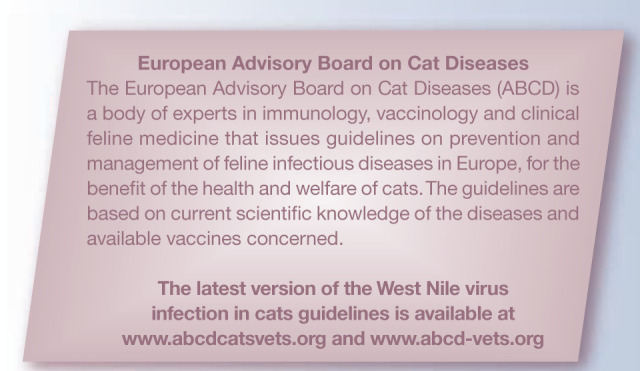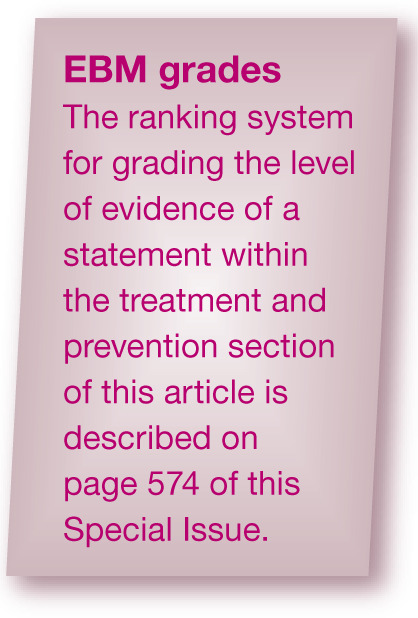Abstract
Overview:
West Nile virus (WNV) is a zoonotic mosquito-borne virus with a broad host range that infects mainly birds and mosquitos, but also mammals (including humans), reptiles, amphibians and ticks. It is maintained in a bird–mosquito–bird transmission cycle. The most important vectors are bird-feeding mosquitos of the Culex genus; maintenance and amplification mainly involve passerine birds. WNV can cause disease in humans, horses and several species of birds following infection of the central nervous system.
Infection in cats:
Cats can also be infected through mosquito bites, and by eating infected small mammals and probably also birds. Although seroprevalence in cats can be high in endemic areas, clinical disease and mortality are rarely reported. If a cat is suspected of clinical signs due to an acute WNV infection, symptomatic treatment is indicated.
Introduction
West Nile virus (WNV) is a zoonotic mosquito-borne virus belonging to the family Flaviviridae, genus Flavivirus, in the Japanese encephalitis antigenic group. It is an enveloped virus containing a single molecule of linear, positive-sense, single-stranded RNA. Several phylogenetic lineages can be distinguished but most isolates can be assigned to lineages 1 and 2. WNV has a broad host range, comprising mainly birds and mosquitos, but also mammals (including humans), reptiles, amphibians and ticks. It can cause disease in humans, horses and several species of birds. The severity of disease depends on the (neuro)virulence of the infecting virus strain. Disease is uncommon in other wild and domesticated animals, and has been incidentally reported in alpacas, sheep, reindeer, dogs and also cats. 1
Epidemiology
WNV was first identified in 1937 from the blood of a febrile patient in the West Nile district of Uganda. Since then, the virus has spread from Africa via migratory birds to other parts of the world including Central and Southern Europe, Asia and Australasia.1,2 In 1999, the virus was introduced into North America, in the city of New York, causing encephalomyelitis in horses, birds and humans. Since then, the virus has spread across the USA and parts of Latin America and Canada. 3
WNV is maintained in a bird–mosquito–bird transmission cycle. The most important vectors are bird-feeding mosquitos of the Culex genus. More than 300 species of birds have been reported to be infected with WNV, but maintenance and amplification mainly involve passerine birds. 4 These birds develop viraemia levels that are sufficient to infect mosquitos feeding upon them. Mortality differs between bird species. High mortality is seen especially in corvids and robins. In other species of wild birds, and also chickens and pigeons, infection remains subclinical. In these latter species a low-magnitude viraemia develops which is unlikely to be sufficient to again infect mosquitos. Humans and other mammals also develop low levels of viraemia and are therefore considered dead-end hosts and not important as virus reservoirs. 1

Pathogenesis and clinical signs
Infection occurs mainly through inoculation of virus by a mosquito bite. Initial target cells are keratinocytes and skin-resident dendritic cells (DCs). 5 The latter migrate to draining lymph nodes where initial replication occurs. From there, the virus spreads to visceral organs, including the spleen. The target cells in the spleen and other visceral organs are thought to be DCs, macrophages and neutrophils. Viral replication leads to viraemia. The virus enters the central nervous system (CNS), resulting in inflammation of the medulla, brainstem and spinal cord. 6
Similarly to other mammals and birds, cats can be infected through mosquito bites, but also orally by eating infected small mammals and probably also birds, as evidenced by serological studies and experimental infections. 7 In a serological survey conducted in St Tammany Parish, Louisiana, USA, 9% of cats were shown to be seropositive, with stray cats having almost three times the WNV seroprevalence as family cats, although the difference was not significant. 8 Seropositive cats were also identified in other areas of the USA and in China, with seroprevalence rates ranging from 10–15%.9,10
Although seroprevalence of WNV infection in endemic areas can be high, clinical disease and mortality are rarely reported. It seems that most infections are subclinical in nature.
In 33 cats from Germany with non-suppurative meningoencephalitis of unknown origin, positive immunostaining was detected for WNV antigen in four cats. All four cats had shown neurological signs. However, WNV infection could not be confirmed by PCR analysis and the positive WNV reactions might have been due to infections with cross-reactive agents or caused by molecular mimicry of host-derived antigens.11,12
During the 1999 outbreak of West Nile virus infections in New York, mortality was observed in humans, horses and one cat. 13 In cats that were experimentally infected through mosquito bites, mild, non-specific signs including lethargy and a modest decrease in appetite were observed during the first week after challenge. No neurological signs occurred. 7 Infection could also be established after oral exposure through ingestion of infected mice. The magnitude and duration of viraemia was similar to that in cats infected by mosquito bites. However, clinical signs were not observed. The level of viraemia in cats was higher than that in dogs included in the same study. The duration of viraemia ranged from 3.5–4.5 days. The level of viraemia observed in cats might be high enough to infect mosquitos at low efficiency. However, cats are not considered to be epidemiologically important amplifying hosts. 7

Diagnosis
Since feline WNV infection is mostly subclinical, the need for specific diagnostic tests for cats is limited. In humans and horses, a diagnosis of WNV infection can be established through detection of the virus or virus-specific antibodies. Acute infection can be confirmed by detecting virus-specific immunoglobulin M antibodies, although antibodies may be absent in the early phase of infection. A significant rise in WNV antibodies in paired acute and convalescent sera can be determined as evidence of acute infection. A test for neutralising antibodies can also be performed, but this requires special facilities and will not be offered by most laboratories. Other serological assays are performed, such as an epitope-blocking ELISA. 14 If they are to be used in the diagnosis of infection in cats these assays need to be standardised for use with feline sera.
Virus can be detected by reverse transcription PCR in blood samples or infected tissues at necropsy. However, viraemia is short-lived and PCR might be negative in a patient at the time of clinical presentation. Virus can also be detected in tissues by in situ hybridisation and immunohistochemistry.
Treatment and prevention
There is no specific treatment for WNV infection. In a cat with clinical signs suspected to be due to WNV infection, symptomatic treatment is indicated.
Several vaccines are available for protection against WNV infection in horses. The efficacy of a recombinant canarypox-vectored WNV vaccine was also studied in dogs and cats. 15 As expected, clinical signs did not develop in any of the cats (control and vaccinated animals) after challenge. However, the vaccinated cats were shown to develop virus-neutralising antibodies and were protected against viraemia after challenge. This demonstrates the potential of the vaccine for protection against infection in cats [EBM grade II]. A commercial vaccine for cats is not available. Since current WNV strains cause no or only minimal and occasional clinical signs, a feline vaccine is currently not required.
Mosquito control can reduce the risk of infection. Similar control measures as implemented for prevention of mosquito bites in humans and horses might be taken.
Key points
West Nile virus (WNV) has a broad host range, infecting mainly birds and mosquitos, but also mammals (including humans), reptiles, amphibians and ticks.
WNV is maintained in a bird–mosquito–bird transmission cycle.
Infection in cats occurs through mosquito bites or ingestion of infected small mammals and probably also birds.
Clinical disease and mortality are rarely reported in cats.
Experimentally infected cats show mild, non-specific signs including lethargy and loss of appetite.
If a cat is suspected of clinical signs due to acute WNV infection, symptomatic treatment is indicated.
Since current WNV strains cause no or only minimal and occasional clinical signs, a feline vaccine is currently not required.
Footnotes
Funding: The authors received no specific grant from any funding agency in the public, commercial or not-for-profit sectors for the preparation of this article. The ABCD is supported by Merial, but is a scientifically independent body and its members receive no stipends from Merial.
The authors do not have any potential conflicts of interest to declare.
References
- 1. Petersen LR, Brault AC, Nasci RS. West Nile virus: review of the literature. JAMA 2013; 310: 308–315. [DOI] [PMC free article] [PubMed] [Google Scholar]
- 2. Sambri V, Capobianchi M, Charrel R, et al. West Nile virus in Europe: emergence, epidemiology, diagnosis, treatment, and prevention. Clin Microbiol Infect 2013; 19: 699–704. [DOI] [PubMed] [Google Scholar]
- 3. Petersen LR, Hayes EB. West Nile virus in the Americas. Med Clin North Am 2008; 92: 1307–1322. [DOI] [PubMed] [Google Scholar]
- 4. Komar N, Langevin S, Hinten S, et al. Experimental infection of North American birds with the New York 1999 strain of West Nile virus. Emerg Infect Dis 2003; 9: 311–322. [DOI] [PMC free article] [PubMed] [Google Scholar]
- 5. Lim SM, Koraka P, Osterhaus ADME, et al. West Nile virus: immunity and pathogenesis. Viruses 2011; 3: 811–828. [DOI] [PMC free article] [PubMed] [Google Scholar]
- 6. Martin-Acebes MA, Saiz JC. West Nile virus: a re-emerging pathogen revisited. World J Virol 2012; 1: 51–70. [DOI] [PMC free article] [PubMed] [Google Scholar]
- 7. Austgen LE, Bowen RA, Bunning ML, et al. Experimental infection of cats and dogs with West Nile virus. Emerg Infect Dis 2004; 10: 82–86. [DOI] [PMC free article] [PubMed] [Google Scholar]
- 8. Kile JC, Panella NA, Komar N, et al. Serologic survey of cats and dogs during an epidemic of West Nile virus infection in humans. J Am Vet Med Assoc 2005; 226: 1349–1353. [DOI] [PubMed] [Google Scholar]
- 9. Lan D, Ji W, Yu D, et al. Serological evidence of West Nile virus in dogs and cats in China. Arch Virol 2011; 156: 893–895. [DOI] [PubMed] [Google Scholar]
- 10. Levy JK, Lappin MR, Glaser AL, et al. Prevalence of infectious diseases in cats and dogs rescued following Hurricane Katrina. J Am Vet Med Assoc 2011; 238: 311–317. [DOI] [PubMed] [Google Scholar]
- 11. Schwab S, Herden C, Seeliger F, et al. Non-suppurative meningoencephalitis of unknown origin in cats and dogs: an immunohistochemical study. J Comp Pathol 2007; 136: 96–110. [DOI] [PMC free article] [PubMed] [Google Scholar]
- 12. Schaudien D, Schwab S, Linke S, et al. Lack of detectable West Nile virus RNA in brains and kidneys of dogs and cats with immunohistological precipitates using virus-specific antibodies. Vet Microbiol 2008; 132: 171–176. [DOI] [PubMed] [Google Scholar]
- 13. Komar N. West Nile viral encephalitis. Rev Sci Tech 2000; 12: 166–176. [DOI] [PubMed] [Google Scholar]
- 14. Blitvich BJ, Bowen RA, Marlenee NL, et al. Epitope-blocking enzyme-linked immunosorbent assays for detection of West Nile virus antibodies in domestic mammals. J Clin Microbiol 2003; 41: 2676–2679. [DOI] [PMC free article] [PubMed] [Google Scholar]
- 15. Karaca K, Bowen R, Austgen LE, et al. Recombinant canarypox vectored West Nile virus (WNV) vaccine protects dogs and cats against a mosquito WNV challenge. Vaccine 2005; 23: 3808–3813. [DOI] [PubMed] [Google Scholar]


